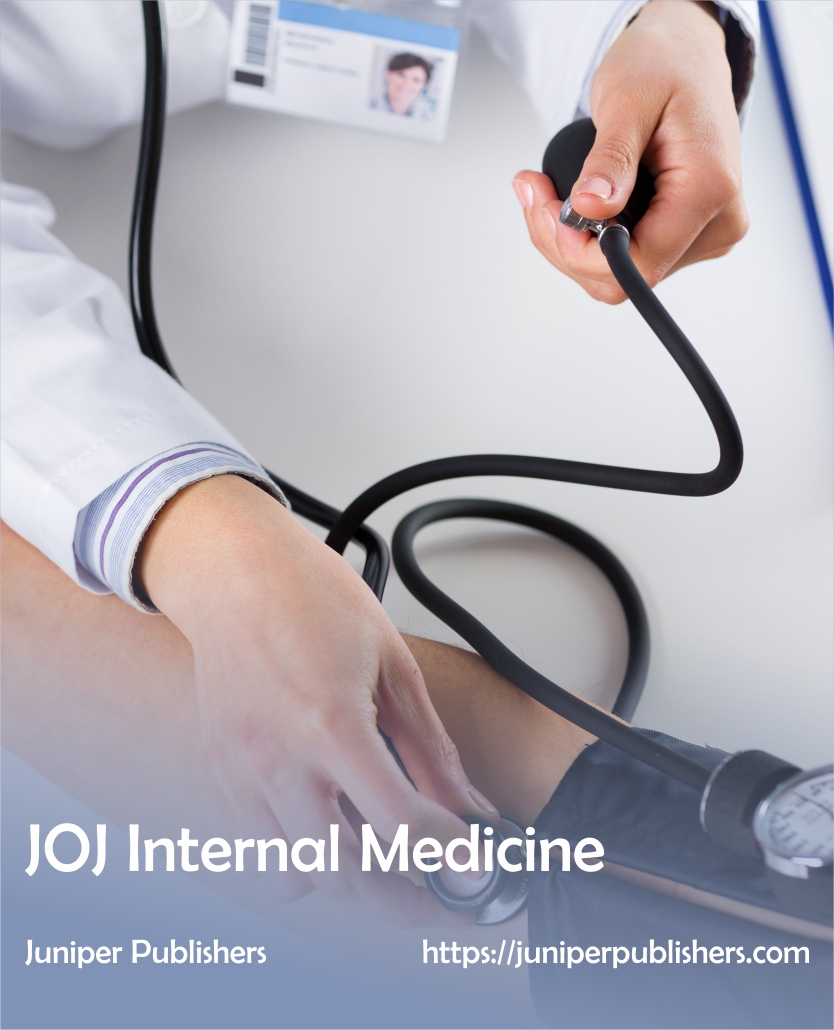The Analysis of Methamphetamine Seized in Singapore
Chan KB*, Angeline TW Yap, Wendy JL Lim, Sylvia Tan, Tan Ying Ying, Yu Lijie, Elaine Lim Yi Lin and Maria Lieka
Illicit Drugs Laboratory, Applied Sciences Group, Singapore
Submission: September 26, 2019; Published: November 05, 2019
*Corresponding author: Chan KB, Illicit Drugs Laboratory, Applied Sciences Group, Health Sciences Authority, 11 Outram Road, 169078 Singapore
How to cite this article: Chan KB, Angeline TW Yap, Wendy JL Lim, Sylvia Tan, Tan Ying Ying, Yu Lijie, Elaine Lim Yi Lin and Maria Lieka. The Analysis of Methamphetamine Seized in Singapore. JOJ Int Med. 2019; 1(3): 555561.
Abstract
In 2015, methamphetamine presented as crystalline methamphetamine hydrochloride called “ice” replaced heroin as the most abused drug in Singapore. Confiscations involving methamphetamine in the form of “wy” or “Yaba” tablets were far less common. Smoking is the most popular mode of administration for both forms of the drug. This mini-review presents a snapshot of recent seizures and an assessment of their liquid chromatographic (LC) and gas chromatographic (GC) quantifications. The long-term participation in an ISO accredited international proficiency testing (PT) program and the continual monitoring and assessment of our PT performance attest to the accuracy and traceability of the methamphetamine quantifications. A comparison of the laboratory’s LC and GC quantitative methods using split samples did not show a significant difference at the 95% confidence level. Virtually all ice seizures of weight ≤ 10 g, supposedly representing the lowest level of the drug distribution hierarchy, were more than 97% in purity. Chiral measurements by polarimetry, LC and GC revealed that d-methamphetamine was the predominant isomer.
Keywords: Methamphetamine hydrochloride Ice Proficiency testing
Introduction
The United Nations’ World Drug Report 2012 indicated that worldwide there was a marked increase in methamphetamine seizures in 2010 when they surpassed that of amphetamine for the first time since 2006. This was due to significant increase in seizures in East and South-East Asia, and Mexico. Large scale crystalline methamphetamine manufacture continues in East and South-East Asia and with these regions accounting for the largest seizures reported worldwide. The methamphetamine sold is mainly in the form of crystalline methamphetamine HCl commonly called “ice”, and as methamphetamine tablets called “yaba” or “wy” tablets. Smoking is a common mode of administration for both forms of the drug [1]. The recent “Myanmar Opium Survey 2017” report from the UN Office on Drugs and Crime (UNODC) revealed that opium poppy cultivation in the Shan and Kachin states of Myanmar fell by 25% accounting for a potential drop of 14% in opium output from 2015 to 2017. This translated to a decrease of about 100 metric tons of opium. This drop-in opium cultivation occurred with the corresponding fall in opium and heroin prices in recent years as most countries in East and Southeast Asia reported a shift towards synthetic drugs, especially methamphetamine [2]. In a geographical position close to the Golden Triangle, Singapore has witnessed this changing of the guards – a few decades with heroin as number one drug being replaced by methamphetamine in 2015; while in neighbouring Malaysia it was reported that ice seizures (1190 kg) had surpassed that of heroin (435 kg) by weight in 2017 [3] and the country recorded its largest single ice seizure of 1.18 tons in May 2018.
[4] The Singapore illicit drug market is a relatively small one, but it may yet provide a useful insight into the dynamics of the regional drug scene owing to Singapore’s location and position as a major global commerce and transport hub. In Singapore there were only a few cases of ice before 1996 and its abuse was confined to a small group of foreigners. [5] However, from 1997 it rapidly gained popularity amongst local abusers and in 2015 its surpassed heroin as the most abused drug in terms of number of seizures. Methamphetamine base, a liquid at ambient temperature, has not been known to be found in drug confiscations here. Figure 1 shows the seizure distribution for the major drugs of abuse and the continuing trend for 2016. Seizures of “wy” tablets, almost the only other form of methamphetamine encountered, were much smaller both in number and size as compared to ice. Amphetamine is very seldom encountered. Methamphetamine which is regulated in Singapore under the Misuse of Drugs Act of 1985 was written as “methylamphetamine” and listed as a Class B controlled drug. It was subsequently re-scheduled as a Class A controlled drug from 16 June 1995. The name “methylamphetamine” was then changed to “methamphetamine (also known as methylamphetamine)” effective 17 October 1997. In 20 July 1998, methamphetaminewas included in Section 17 of the Act for the presumption of trafficking of more than 25 grams (as base) as well as in the Second Schedule for capital punishment of more than 250 grams (as base).
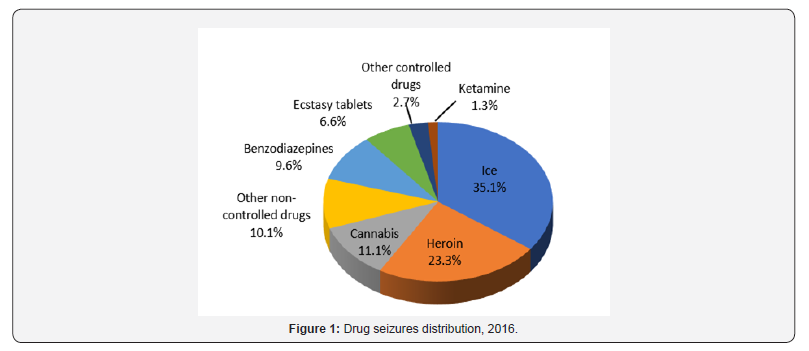
Under this Act there is no differentiation of the enantiomeric form of the methamphetamine whether dextrorotatory, laevorotatory or an enantiomeric mixture, unlike for example in the USA where the Federal courts mandate heavier penalties for possession or sale of enantiomerically pure d-methamphetamine HCl of at least 80% purity. [6] In this mini-review, we present data on the number, size and purity of ice seizures for the past few years. The accuracy and traceability of the liquid chromatographic and gas chromatographic quantifications are continually monitored and assessed from results obtained in an ISO accredited international PT program.
Ice Seizures and purity

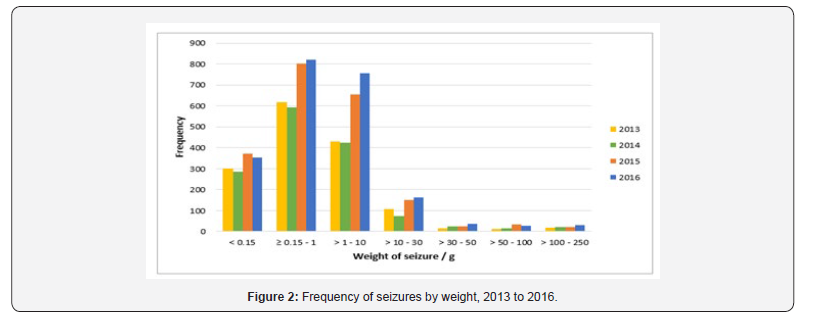
All ice seizures of net weight ≥ 0.15 g submitted to the Illicit Drugs Laboratory (IDL) are quantitated using a liquid chromatographic (LC) method. A high-performance liquid chromatographic (HPLC) method was used to determine the methamphetamine base content until 2012 when it was replaced with an ultra-high-performance liquid chromatographic (UHPLC) method. Table 1 shows the number, weight and purity of the ice seizures which were analysed quantitatively for the period from 2013 to 2016 [7]. The annual normalised or weighted purity was obtained by dividing the total methamphetamine base weight found with the net weight of all the seizures for the year and expressed as a percentage. The frequency of all seizures ≤ 250 g is indicated in Figure 2. Seizures of ≤ 10 g made up about 90% of all cases examined and generally their purity was above 97% (as HCl). The lower normalised purity for 2013 and 2014 (compared to the high of 97.6% for 2015 and 2016) were attributed to several large seizures which had been adulterated with dimethyl sulfone. In 2013 there were 7 large seizures with a total weight of 19.43 kg and a mean purity of 73.4%, while in 2014 there were 4 large seizures of total weight of 9.04 kg and a mean purity of 69.7%. All these were found to be cut with dimethyl sulfone. A recent high purity ice seizure (> 98% as methamphetamine HCl) and close-up of the crystals are shown in Figure 3.
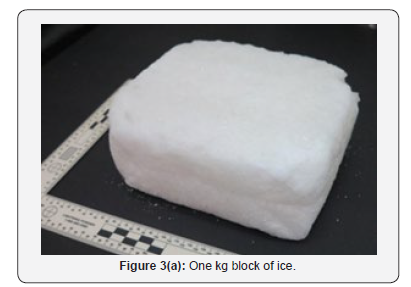
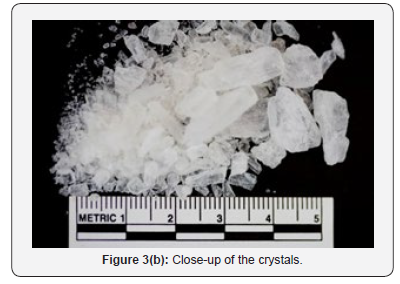
LC Quantification and External Proficiency Testing
In IDL, most of the quantitative methods are based on liquid chromatography. All these methods have been validated to meet the requirements of the American Society of Crime Laboratory Directors/ Laboratory Accreditation Board (ASCLD/ LAB) which the laboratory has been accredited since June 1996. The current ASCLD/LAB accreditation standard is based mainly on the ISO 17025:2005. In tandem to meeting the requirements of Section 5.9 of ISO 17025:2005 with regard to assuring the quality of test results, and the continual assessment of the laboratory’s performance, our laboratory has been participating in an international PT program organised by the National Measurement Institute (NMI), Australia since 1998.7 Participation and comparison to proficiency test results is one of the recommended ways of determining the accuracy of quantitative methods used by a laboratory [8]. The consensus value of a PT result can be regarded as a good approximation of the true value and hence the bias of an individual result can be found. This holds especially if there are more than 30 participants using the same technique [9]. Figure 4 shows the cumulative z-scores plot for 9 methamphetamine PT rounds from 2002 to 2017. Each PT round consisted of 3 samples except the last round in 2017 with 2 samples of methamphetamine. Samples No. 1 to 15 were determined by a HPLC method while samples No. 16 to 26 were determined with an UHPLC method introduced in 2012. In the assays, each PT sample result was the average determined from 2 separate weighing’s. All the PT results were satisfactory (z-scores ≤ 2) and there was no indication of a trend or bias in the quantifications from this long-term monitoring [10-12].
It is noteworthy that the NMI PT provider sometimes determined the reference value of the PT sample(s) instead of using the consensus value. Compared to the consensus value, which was either the median or robust average, the reference value established by a primary technique such as quantitative nuclear magnetic resonance spectrometry (QNMR) provided better traceability and hence greater confidence in the assessment of the accuracy of the PT result [13]. Referring to Figure 4 again, the z-scores of PT Sample No. 21 and 22 were based on reference values determined by QNMR. The measurement of these two reference values are traceable to the SI unit (kilogram) through the Australian Standards for mass via balance calibration certificates and the purity of the maleic acid certified reference material that was used as the internal standard. Furthermore, in the absence of a reference value and where applicable, NMI provided the homogeneity value and/or the gravimetric value of the PT sample. Along with the consensus value, these can help to assess the accuracy of a PT result. Measurement uncertainty of quantitative methods is a condition of accreditation and provides confidence in decisions based on results. Thus, while the z-score provides an assessment of the result relative to the assigned value (usually the consensus value), the En score gives an assessment of the uncertainty estimate [14]. Participation inthe NMI PT program enabled the measurement uncertainty of the results to be compared with those of other international peer laboratories and, the uncertainty of the assigned values. From the long-term monitoring of the En scores, the estimate of the uncertainty of our LC method has been assessed to be reasonable and realistic.
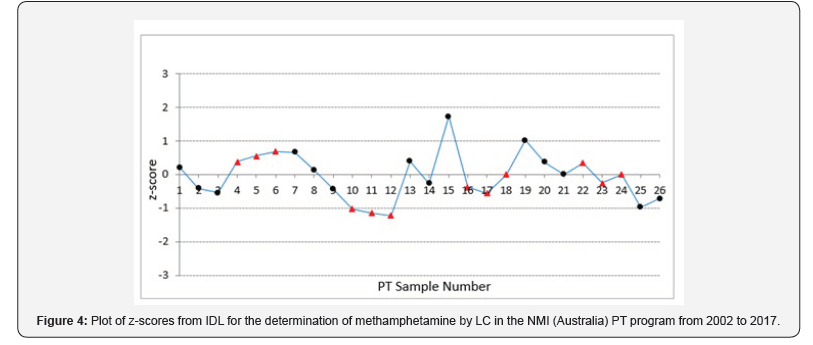
Comparison with GC-Fid Quantification
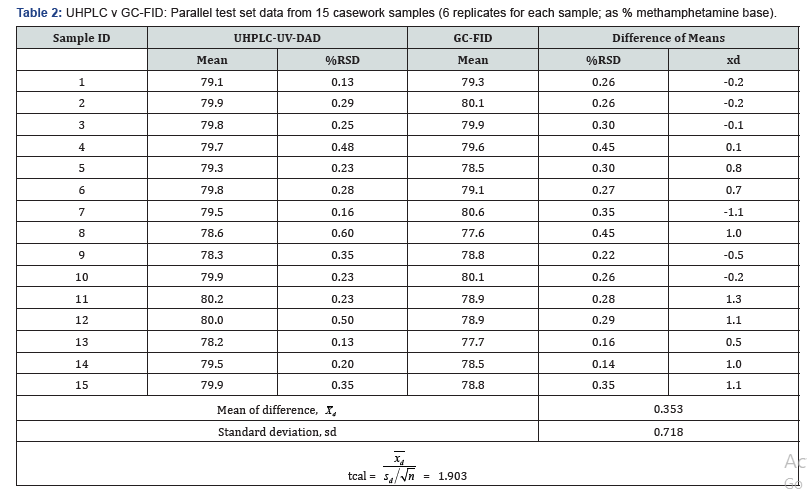
For large seizures that may commensurate with a more severe penalty, in addition to LC quantification, a gas chromatographyflame ionisation detector (GC-FID) assay is made. The LC and GCFID quantifications are carried out in parallel using split samples from 6 weighed aliquots randomly drawn from a pulverised and homogenised bulk sample. Both techniques use an internal standard method and the split samples are analysed within a short period of time. However, unlike for the GC-FID quantification of heroin and cocaine, methamphetamine is determined in the base form as the peak shape and reproducibility of response of methamphetamine in GC are better if it is injected as the base rather than the hydrochloride [15]. Thus, though split samplesare used to minimise the variability due to sample preparation for the two techniques, the GC-FID method has an additional step of conversion to the base and its extraction into an organic solvent. In spite of this extra step we find very good agreement between the two methods. A comparison of 15 different seizures of highly pure ice using the paired t-test (Student) showed that there was no significant difference between the two analytical methods Table 2. The critical value of t in this instance (P = 0.05, two-tailed, 14 degrees of freedom) is 2.145. The experimental value of t (1.903) is below this, indicating that the null hypothesis can be retained and that no significant difference between the two methods can be shown (from Microsoft Excel, P = 0.077) [16]. The F-test showed that precision of the 15 parallel sets of results were not significantly different at 95% confidence level (Fcritical = 7.15, Fcal ranged from 1.01 to 4.63), and the pooled % RSD of the UHPLC and GC-FID determinations were 0.32% and 0.30% respectively.
Although the NMI PT methamphetamine samples were provided in limited amounts, our split-sample design allowed additional GC-FID quantifications for comparison with the default LC assays. As in the case for the highly pure ice samples, we did not find any significant difference between the two techniques when applied to the PT methamphetamine samples with lower purities and more complex matrices.
Mode of Ice Administration
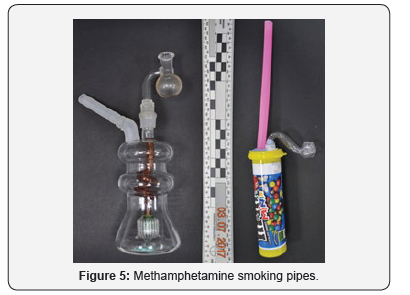
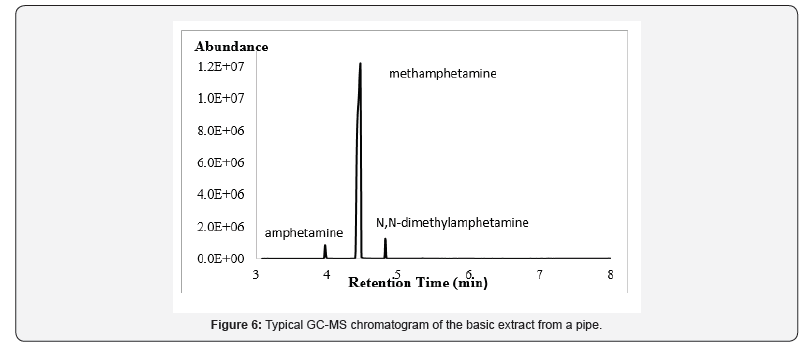
Although crystalline methamphetamine HCl can be injected, snorted as a fine powder, or mixed with tobacco and smoked, [17-20] the most popular mode of administration in Singapore appears to be by the use of a smoking device such as a pipe, a practice known as “chasing the white dragon” [21]. This is supported by the number of drug taking utensils submitted to the laboratory for analysis and from anecdotal information provided by law enforcement authorities. In 2016, out of the 509 suspected drug administration paraphernalia examined, 284 (56%) tested positive for the presence of methamphetamine. These ranged from pieces of aluminium foils to improvised smoking devices and sophisticated glass pipes incorporating a water filter Figure 5. Besides methamphetamine, the pyrolysis products amphetamine and N, N-dimethylamphetamine22 were also often detected. Figure 6 shows a typical GC-MS profile of the basic extract from a smoking device.
Enantiomeric Form of Ice Seizures
Whilst the Singapore legislation does not differentiate the enantiomeric forms of the methamphetamine, the determination of a particular stereoisomer along with its impurities profile can provide useful intelligence information about the synthetic pathway to produce methamphetamine [22]. A 2004 survey of the enantiomeric form of 64 seized ice samples revealed that 36 samples (56%) were of the dextro form, 11 were levo and 17 were racemic. This was accomplished using chiral column GC after derivatisation of the samples with trifluoroacetic anhydride [23]. The samples were also checked by polarimetry. A later survey in 2009 showed that of the 95 samples analysed, 89 samples (94%)were dextro, 2 were levo and 4 were non-racemic mixtures with the dextro content ranging from 15% to 96%. More recent (January-June 2016) polarimetric measurements of 435 samples of purity > 75 % (as base) revealed that, except for 2 levo isomer samples, all were of the dextro form. The predominance of this enantiomeric form was also observed in Malaysia in 2005 where out of 74 samples analysed at the Department of Chemistry Malaysia with a chiral column LC procedure, [24] 71 samples (96%) were found to be dextrorotatory and 3 racemic [25].
Conclusion
Methamphetamine, almost exclusively in the form of ice, is now the number one drug of abuse in Singapore. A snapshot of the most prevalent forms of the drug is presented as well as analytical data attesting to its precise and accurate quantifications by LC and GC. As in the case of street heroin here,34 the ice analytical data agree with Coomber’s assertion that dealer adulteration of drugs is not as prevalent as has been claimed [26-27]. Virtually all ice seizures of weight ≤ 10 g, supposedly representing the lowest level of the drug distribution hierarchy, were more than 97% in purity. The analytical data on crystalline methamphetamine HCl appear to show that the use phenyl 2-propanone to make illicit methamphetamine is not commonplace in this region. However, this is based on very small sample sizes; and the limited seizures, albeit covering several years, may not adequately reflect the trend of the huge Southeast Asian illicit methamphetamine market.
References
- World Drug Report (2018) United Nations Office on Drugs and Crime, United Nations.
- Myanmar Opium Survey (2017) UNODC Regional Office for Southeast Asia and the Pacific.
- Almost RM200 mil in drugs seized in Malaysia (2017) New Straits Times.
- Customs Dept nets 1.1 tonnes of meth worth RM71 mil; biggest haul in its history [NSTTV] (2018) The New Straits Times.
- Lee TK, Chow ST, Ng TL (1998) A 10-year review of drug seizures in Singapore. Med Sci Law 38(4): 311-316.
- (2004) Unusual Ice Methamphetamine Laboratory Seized in Guam. Microgram Bulletin 37(3): 50-51.
- Armishaw P, King B, Millar RG (2003) Achieving traceability in chemical measurement-a metrological approach to proficiency testing. Accred Qual Assur 8: 184-190.
- E2549: Standard practice for validation of seized-drug analytical methods (2014) ASTM International, USA.
- Kuselman I, Belli M, Ellison SLR, Fajgelj A, Sansone U, et al. (2007) Comparability and compatibility of proficiency testing results in schemes with a limited number of participants. Accred Qual Assur 12: 563-567.
- Thompson M (2016) z-Scores and other scores in chemical proficiency testing-their meanings, and some common misconceptions. Anal Methods 8: 5553-5555.
- Thompson M, Lowthian PJ (1993) Effectiveness of analytical quality control is related to the subsequent performance of laboratories in proficiency tests. Analyst 118(12): 1495-1500.
- Ellison SLR, Barwick VJ, Farrant TJD (2009) Practical Statistics for the Analytical Scientist. In: RSC Publishing, Uk, pp. 187-188.
- Proficiency Test Report AQA 16-01 (2017) Methamphetamine. National Measurement Institute, Australia.
- Traceability in Chemical Measurements (2005) In: De Bièvre P, Günzler H (Eds), Verlag Berlin Heidelberg, US, pp. 118-119.
- Power Jr JA (1990) Failure to detect methamphetamine by gas chromatographic screening in the presence of chloromethamphetamine. Microgram Bulletin, 23(6): 116-117.
- Miller JN, Miller JC (2010) Statistics and Chemometrics for Analytical Chemistry. In: 6th (edn)., Pearson Education Limited, Uk, pp. 43-45.
- Kinner SA, Degenhardt L (2008) Crystal methamphetamine smoking among regular ecstasy users in Australia: increases in use and associations with harm. Drug Alcohol Rev 27(3): 292-300.
- Sekine H, Nakahara Y (1987) Abuse of smoking methamphetamine mixed with tobacco: I. Inhalation efficiency and pyrolysis products of methamphetamine. J Forensic Sci 32(5): 1271-1280.
- Harris DS, Boxenbaum H, Everhart T, Sequeira G, Mendelson JE, et al. (2003) The bioavailability of intranasal and smoked methamphetamine. Clin Pharmacol Ther 74(5): 475-486.
- Cook CE, Jeffcoat AR, Hill JM, Pugh DE, Patetta PK, et al. (1993) Pharmacokinetics of methamphetamine self-administered to human subjects by smoking S-(+)-methamphetamine hydrochloride. Drug Metab Dispos 21(4): 717-723.
- Schifano F, Corkery JM, Cuffolo G (2007) Smokable (“ice”, “crystal meth”) and non smokable amphetamine-type stimulants: clinical pharmacological and epidemiological issues, with special reference to the UK. ANN IST SANITA 43(1): 110-115.
- Sato M, Hida M, Nagase H (2004) Analysis of pyrolysis products of methamphetamine. J Anal Toxicol 28: 638-643.
- Drake SJ, Morrison C, Smith F (2011) Simultaneous chiral separation of methylamphetamine and common precursors using gas chromatography/mass spectrometry. Chirality 23(8): 593-601.
- Makino Y, Urano Y, Nagano T (2002) Impurity profiling of ephedrines in methamphetamine by high-performance liquid chromatography. J Chromatogr A 947(1): 151-154.
- Evaluation of alternative precursor use in Southeast Asia (2007) Drug Net Asia 6: 1-6.
- Coomber R (1997) Vim in the veins-Fact or fantasy: The adulteration of illicit drugs. Addiction Research 5(3):195-212.
- Coomber R (1997) The adulteration of drugs: What dealers do to illicit drugs, and what they think is done to them. Addiction Research 5(4): 297-306.

